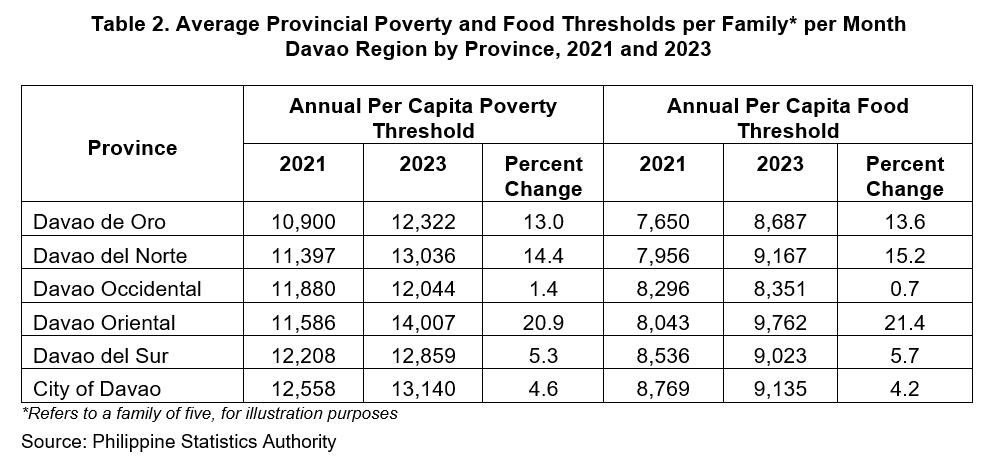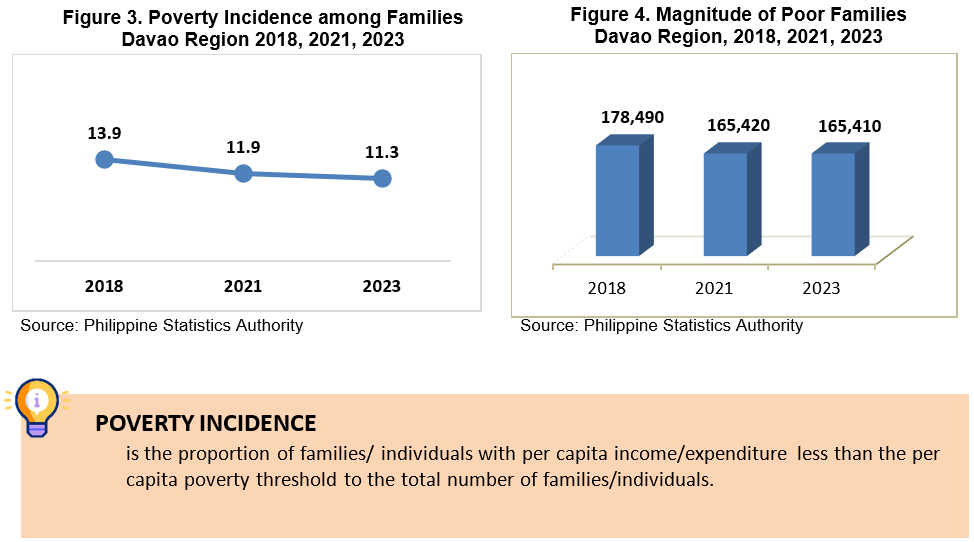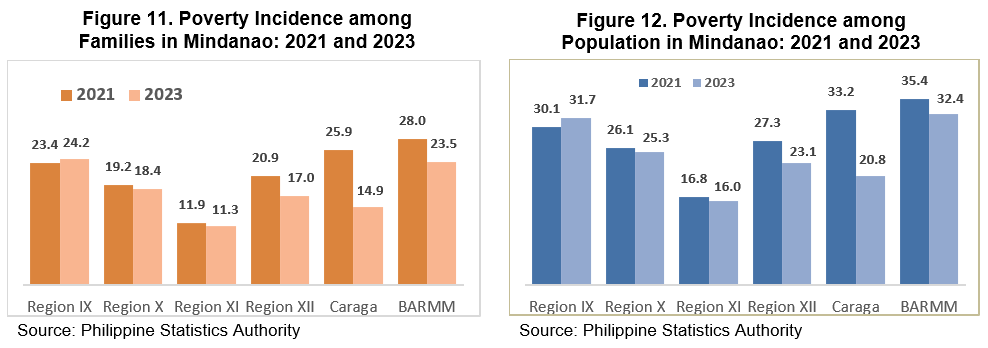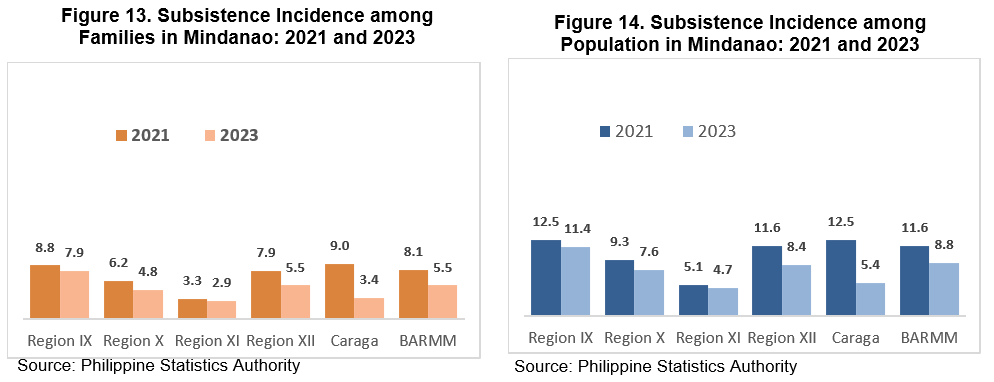PhP 13,134 needed to stay out of poverty
Latest estimates released by the Philippine Statistics Authority (PSA) showed that in Davao region, a family consisting of five members must have had a total income of
PhP 157,607 in 2023 or an average monthly income of PhP 13,134 to be able to meet their most basic food and non-food needs.
The annual per capita poverty threshold in Davao region was estimated at PhP 31,521 in 2023. This means that, in 2023, an individual needed a monthly income of at least PhP 2,627, or a daily income of PhP 432 to stay out of poverty.
On the other hand, the annual per capita food threshold or the income needed for sustaining basic food needs in 2023 was estimated at PhP 22,065. With this amount, a Davaoeño family of five members must have had an annual income of PhP 110,323 or PhP 302 daily for them to provide for their basic food requirements.
Both per capita poverty and per capita food thresholds in the region increased by about 12 percent or an average of about 4.0 percent per year between 2021 and 2023. (Table 1)

The region’s level of monthly poverty and food thresholds for a family of five were PhP 739 and PhP 387 lower than the estimates at the national level, respectively. (Figures 1 and 2)


Among the provinces in Davao Region, Davao Oriental had the highest monthly income requirement for a family of five in 2023 with PhP 14,007 up by 20.9 percent compared to 2021 estimate of PhP 11,586. On the other hand, Davao Occidental had the lowest threshold in the same period with PhP 12,044 up by 1.4 percent compared to 2021 level of PhP 11,880. Similarly, in 2023, Davao Oriental and Davao Occidental had the highest at PhP 9,762 and lowest at PhP 8,043 food threshold. (Table 2)

Eleven out of 100 families are poor
The poverty incidence among families in Davao Region was estimated at 11.3 percent, or roughly 11 out of 100 families were estimated to be poor in 2023 or have income below the amount needed to buy their minimum basic food and non-food needs. The estimate was lower than the 2021 and 2018 poverty incidence figures, which were estimated at 11.9 percent and 13.9 percent, respectively. (Figure 3)
In terms of number, Davao region recorded about 165,410 poor families or families having income less than the poverty threshold in 2023. (Figure 4)

Meanwhile, the subsistence incidence or the proportion of Davaoeno families in extreme poverty whose incomes are not sufficient to meet basic food needs stood at 2.9 percent in 2023. With this incidence, the estimated number of families not able to afford basic food needs was 42,660 in 2023. (Figures 5 and 6)

Sixteen out of 100 Davaoeños poor
The latest poverty estimates also indicated that 16.0 percent of Davaoeños were not able to meet the basic food and non-food requirements in 2023. This was estimated at 16.8 percent in 2021 and 19.1 percent in 2018. The magnitude of poor population in the region was estimated at 884,830 in 2023. (Figures 7 and 8)

On the other hand, in 2023 the subsistence incidence among individuals stood at 4.7 percent. With this incidence, the magnitude of Davaoenos who were not able to meet basic food requirements was estimated at 258,250. (Figures 9 and 10)

Davao’s poverty incidence is the lowest in Mindanao
Among the regions in Mindanao, Davao Region, remained with the lowest poverty incidences of both families and individuals with Zamboanga Peninsula having the highest at 24.2 percent poverty incidence among families in 2023. Meanwhile, BARMM got the highest poverty incidence among population in 2023 having 32.4 percent. (Figures 11 and 12)

In terms of subsistence among families and among population, the highest incidences were recorded in Region IX in 2023, at 7.9 percent and 11.4 percent, respectively. In the same period, Region XI had the lowest subsistence incidences among families and individuals with 2.9 percent and 4.7 percent, respectively. (Figures 13 and 14)

Between 2021 and 2023, all regions in Mindanao experienced a reduction in the number of poor families and individuals, except Region IX. The magnitude of poor families in Region IX increased by 6.2 percent from 204.59 thousand in 2021 to 217.28 thousand in 2023 while the number of poor individuals increased by 6.7 percent from 1.1 million to 1.2 million. (Table 3)

Poverty in Davao Region provinces and HUC
Figure 15 shows the poverty incidences among Filipino families in the provinces and HUC of Davao Region. As shown, Davao Oriental reflected the highest estimate in 2023 at 29.1 percent, followed by Davao Occidental at 19.8 percent, Davao del Sur at 10.1 percent, Davao City at 8.8 percent and Davao de Oro with the lowest at 7.1 percent.

In terms of magnitude, Davao City had the most with almost 50 thousand poor families, followed by Davao Oriental with about 45 thousand families that were not able to afford basic food and non-food needs in 2023. (Table 4)

Figure 16 shows the poverty incidences among the population in the provinces and HUC of Davao Region. The poverty incidence was estimated at 38.9 percent in Davao Oriental, 27.9 in Davao Occidental, 14.3 percent in Davao del Sur, 12.3 percent in Davao City, 11.1 percent in Davao del Norte, and 10.2 percent in Davao de Oro.

In terms of magnitude, Davao Oriental had the largest number of poor population with about 242 thousand people, closely followed by Davao City with about 241 thousand poor individuals. (Table 5)

The provinces were grouped into 6 categories based on the recorded poverty incidence among families.
Group 1 represents the poorest group or the provinces with poverty incidence greater than 50 percent while Group 6 represents the least poor group or the provinces with incidence rates that are 10 percent or lower.
It can be observed that 2 out of 6 provinces (including HUC) shifted from group 5 in 2018 to group 6 in 2023. During this year, three provinces/huc in Davao Region belong to group 6, namely: Davao de Oro, Davao del Norte and Davao City.
Davao Occidental improved from group 3 in 2018 to group 5 in 2023, while Davao Oriental and Davao del Sur remained in the same group in 2018 and 2014, group 4 and 5, respectively. (Table 6)

These thematic maps show the grouping of provinces based on poverty incidence among families. Areas shaded in red, and orange represent provinces/huc in the poorest group, which are groups 1 and 2 while provinces/huc in dark green belong to the least poor groups, which are groups 5 and 6. Notice that Davao del Norte transitioned from light green to dark green between 2018 and 2021.
Comparing the maps of 2021 and 2023, it can be observed that Davao de Oro shifted from light green to dark green joining Davao del Norte, Davao del Sur, and Davao City. Davao Occidental also shifted from orange to light green.

Income Gap, Poverty Gap and Severity of Poverty
In addition to the thresholds and incidences, the PSA also releases other poverty-related statistics such as income gap, poverty gap and severity of poverty. In Davao region, the income gap was estimated at 20.6 percent in 2023. This means that on average, a poor Davaoeño family with five members needed an additional monthly income of about PhP 2,811 to move out of poverty in 2023. (Table 7)

Technical Notes:
Food threshold is the minimum income required to meet basic food needs and satisfy the nutritional requirements set by the Food and Nutrition Research Institute to ensure that one remains economically and socially productive. It is used to measure extreme or subsistence poverty.
Poverty threshold is a similar concept, expanded to include basic non-food needs such as clothing, housing, transportation, health, and education expenses.
Poverty Incidence is the proportion of families/ individuals with per capita income/expenditure less than the per capita poverty threshold to the total number of families/individuals.
Subsistence Incidence is the proportion of families/ individuals with per capita income/expenditure less than the per capita food threshold to the total number of families/individuals.
Income Gap measures the average income required by the poor to get out of poverty, expressed relative to the poverty threshold.
Poverty Gap refers to the income shortfall (expressed in proportion to the poverty threshold) of families with income below the poverty threshold, divided by the total number of families.
Severity of Poverty is the total of the squared income shortfall (expressed in proportion to the poverty threshold) of families with income below the poverty threshold, divided by the total number of families. This is a poverty measure that is sensitive to income distribution among the poor.
Approved for release:
RANDOLPH ANTHONY B. GALES
(Chief Statistical Specialist)
OIC-Regional Director
PSA-RSSO XI
